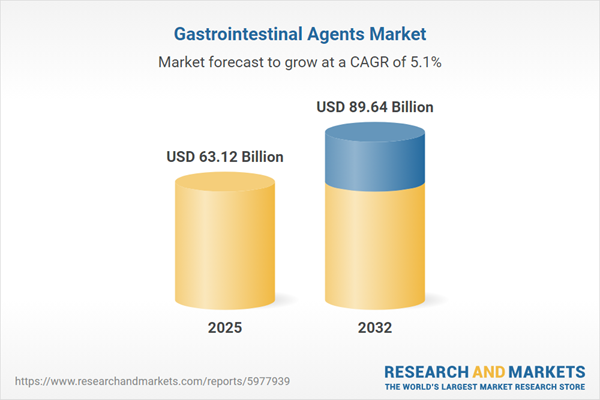Speak directly to the analyst to clarify any post sales queries you may have.
The gastrointestinal agents market is responding to shifting patient expectations, disruptive regulatory environments, and technological advances. It now offers a diverse range of therapies and drug delivery solutions for digestive health—critical concerns for global healthcare providers and pharmaceutical leaders.
Market Snapshot: Gastrointestinal Agents Market
The gastrointestinal agents market grew from USD 60.06 billion in 2024 to USD 63.12 billion in 2025. Continuing at a CAGR of 5.13%, the sector is forecast to achieve USD 89.64 billion by 2032, reflecting persistent demand across both established and emerging economies. This expansion is driven by surging incidences of digestive system disorders and increased attention to preventive measures. Ongoing investments in research, supply chain optimization, and innovative care models are rapidly reshaping the market, creating significant opportunities for strategic engagement.
Scope & Segmentation
This report delivers in-depth analysis and forecasts across comprehensive segments, emphasizing therapeutic breadth and global market reach.
- Product Types: Antacids (aluminum hydroxide, calcium carbonate, combination formulations, magnesium hydroxide, sodium bicarbonate), Anti Diarrheals (adsorbents—bismuth subsalicylate, kaolin pectin; opioid derivatives—diphenoxylate atropine, loperamide), Anti Emetics (dopamine antagonists—metoclopramide, prochlorperazine; NK1 receptor antagonists—aprepitant, fosaprepitant; serotonin receptor antagonists—granisetron, ondansetron, palonosetron), H2 Receptor Antagonists (cimetidine, famotidine, nizatidine, ranitidine), Laxatives (bulk forming—methylcellulose, polycarbophil, psyllium; lubricant; osmotic—lactulose, polyethylene glycol, sorbitol; stimulant; stool softeners), Probiotics & Prebiotics (prebiotics—fructooligosaccharides, inulin; probiotics—bifidobacterium, lactobacillus, saccharomyces boulardii), Proton Pump Inhibitors (esomeprazole, lansoprazole, omeprazole, pantoprazole, rabeprazole)
- Routes of Administration: Oral (capsule, liquid syrup, powder, tablet), Intravenous (bolus injection, infusion), Intramuscular, Topical (creams, gels, suppositories)
- Distribution Channels: Hospital pharmacy, retail pharmacy, online pharmacy
- Geographies: Americas (North America, Latin America), Europe, Middle East & Africa, Asia-Pacific
- Key Players: Includes AbbVie Inc., Takeda Pharmaceutical Company Limited, Pfizer Inc., AstraZeneca PLC, Johnson & Johnson, Otsuka Pharmaceutical Co., Ltd., Novartis AG, GlaxoSmithKline plc, Sanofi S.A., and Bayer AG
Key Takeaways for Decision-Makers
- Analyzing shifts in product demand reveals robust performance in both mature antacid categories and innovative microbiome-based agents, with increased adoption of patient-centric solutions.
- Precision medicine and digital health integration continue to redefine treatment modalities, supporting real-time monitoring, flexible formulations, and improved patient adherence.
- Geographic trends highlight strong momentum in Asia-Pacific markets as well as expansion initiatives focused on both chronic and preventive care in Europe and Latin America.
- Strategic partnerships and vertical integration are favored approaches for expediting pipeline development and commercialization, underscoring the need for agility across supply and distribution networks.
- Segment-specific strategies, including diversification of oral and topical drug delivery platforms, are matched by channels supporting both traditional and online pharmacy growth.
Market Tariff Impact
The 2025 United States tariff regulations have significantly influenced the gastrointestinal therapy supply chain. Manufacturers are diversifying sourcing and production sites, while regional facility expansion and local supplier relationships are being prioritized to optimize cost structures and reduce exposure. The resulting reconfiguration emphasizes supply chain resilience and adaptation to both competitive and quality requirements on a global scale.
Methodology & Data Sources
This research utilizes a mixed-methods approach, coupling qualitative executive interviews from senior leaders throughout the pharmaceutical supply chain with extensive secondary review of peer-reviewed publications and regulatory sources. Triangulation was used to ensure the reliability of findings and deepen the analytical rigor for each segmentation and trend analysis.
Why This Report Matters
- Enables pharmaceutical leaders to clearly identify and address region-specific challenges and opportunities for gastrointestinal agents.
- Supports accelerated go-to-market strategies and performance tracking with insights into evolving digital health, supply chain dependencies, and clinical developments.
- Empowers stakeholders to align product portfolios, refine distribution tactics, and capture market share across diverse global environments.
Conclusion
This report delivers actionable insight into the rapidly advancing gastrointestinal agents market, supporting confident investment and operational decisions. Stakeholders gain clarity on evolving trends, risk factors, and growth levers, fostering sustainable competitive positioning in digestive health therapeutics.
Additional Product Information:
- Purchase of this report includes 1 year online access with quarterly updates.
- This report can be updated on request. Please contact our Customer Experience team using the Ask a Question widget on our website.
Table of Contents
3. Executive Summary
4. Market Overview
7. Cumulative Impact of Artificial Intelligence 2025
Companies Mentioned
The companies profiled in this Gastrointestinal Agents market report include:- AbbVie Inc.
- Takeda Pharmaceutical Company Limited
- Pfizer Inc.
- AstraZeneca PLC
- Johnson & Johnson
- Otsuka Pharmaceutical Co., Ltd.
- Novartis AG
- GlaxoSmithKline plc
- Sanofi S.A.
- Bayer AG
Table Information
| Report Attribute | Details |
|---|---|
| No. of Pages | 182 |
| Published | November 2025 |
| Forecast Period | 2025 - 2032 |
| Estimated Market Value ( USD | $ 63.12 Billion |
| Forecasted Market Value ( USD | $ 89.64 Billion |
| Compound Annual Growth Rate | 5.1% |
| Regions Covered | Global |
| No. of Companies Mentioned | 11 |









